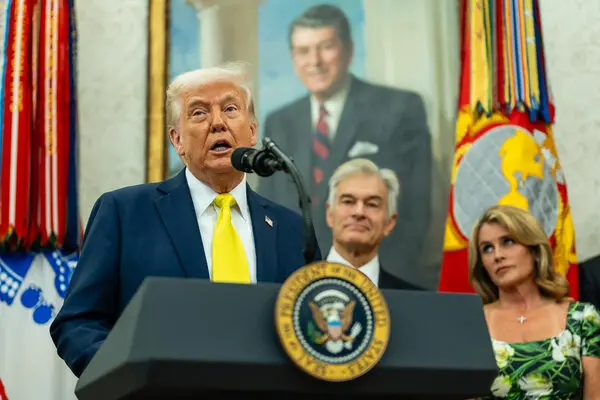Trump’s policy bill Medicaid impact is now at the center of national debate as the former president pushes for sweeping reforms in tax, spending, and healthcare policies. One of the biggest questions being asked is: What does this mean for Medicaid?
Medicaid is a lifeline for over 80 million Americans. It covers low-income families, seniors in nursing homes, and people with disabilities. With Trump’s new bill proposing significant federal spending cuts and structural changes, many experts believe that Medicaid could face its most significant transformation in decades.
In this article, we’ll explore how Trump’s tax and spending bill affects Medicaid, who stands to gain or lose, and what it could mean for the future of healthcare in America.
What’s in Trump’s New Policy Bill?
Donald Trump’s sweeping bill, officially titled the American Prosperity and Reform Act, is a massive piece of legislation that touches nearly every aspect of federal policy. It includes:
- Major tax cuts for corporations and high-income earners
- Large reductions in federal spending
- Changes to entitlement programs like Medicaid and food stamps
- Revisions to how federal funds are distributed to states
Trump and his supporters say the bill will boost economic growth, reduce federal debt, and promote personal responsibility. But critics warn that it may leave millions of low-income Americans without essential services, especially healthcare through Medicaid.
Key Changes to Medicaid in Trump’s Bill
Here’s a breakdown of the main changes to Medicaid proposed in the bill:
1. Shifting to Block Grants
The most significant proposed change is moving Medicaid from an open-ended federal entitlement program to a block grant system.
- Current system: The federal government matches state spending on Medicaid. If more people enroll, the federal government provides more money.
- Proposed system: Each state receives a fixed amount of money, regardless of how many people enroll or how much healthcare costs increase.
Impact: States will have less flexibility to respond to public health crises, economic downturns, or rising medical costs. If funding runs out, states may be forced to cut services or limit enrollment.
2. Work Requirements for Medicaid Recipients
Another major component of the bill is implementing work requirements for “able-bodied” adults on Medicaid.
- Recipients would need to prove they are working, attending school, or participating in job training to remain eligible.
- Exemptions would exist for seniors, people with disabilities, and caregivers.
Impact: While supporters say it encourages self-sufficiency, critics argue that it could disqualify millions who already struggle to find stable employment, especially in low-income or rural areas.
3. Spending Caps and Cost Control Measures
Trump’s bill also introduces per-capita caps — a set amount the federal government would pay per Medicaid enrollee, rather than covering actual costs.
- Each enrollee category (children, adults, elderly, disabled) would have a capped amount.
- States would have to manage any extra costs.
Impact: These caps could lead to rationing care, cutting benefits, or denying services if healthcare costs rise faster than the cap allows.
4. Elimination of Medicaid Expansion Under the ACA
The bill aims to roll back the Affordable Care Act’s Medicaid expansion, which extended coverage to millions of low-income adults.
- Federal funding for expansion would be phased out over several years.
- States that expanded Medicaid may lose billions in federal support.
Impact: Millions could lose coverage, especially in states that embraced expansion under the ACA, such as California, New York, and Michigan.
Who Will Be Most Affected?

The impact of Trump’s policy bill on Medicaid would vary widely by state and population group. Here’s a closer look at who might be most affected:
1. Low-Income Families
Families earning below the poverty line who rely on Medicaid for basic care may lose access to services or face long waits due to budget cuts.
2. Seniors in Nursing Homes
More than 60% of nursing home residents rely on Medicaid. Caps or cuts in funding could force facilities to reduce staff, lower care quality, or shut down.
3. People with Disabilities
Medicaid funds critical support services for people with disabilities. Under block grants or spending caps, states may restrict access to therapies, home care, or medications.
4. Children
Medicaid covers almost 40% of children in the U.S. Any reduction in services could affect vaccinations, early screenings, and treatment for chronic conditions.
Arguments from Both Sides
Supporters Say:
- The bill encourages state-level innovation and cost control.
- Block grants give states more power and responsibility.
- Work requirements promote independence and reduce dependency.
Critics Say:
- Fixed funding does not reflect real healthcare needs.
- Vulnerable populations will be hit the hardest.
- Work requirements create unnecessary red tape and may increase poverty.
What States Might Do
States will have tough choices if the bill passes:
- Some may cut optional services like dental or vision.
- Others may limit eligibility or introduce waitlists.
- A few may raise state taxes or shift funds from other programs.
Each state’s decision will depend on local politics, budget health, and population needs.
Could This Lead to Higher Healthcare Costs?
Ironically, some experts argue that cutting Medicaid could lead to higher long-term healthcare costs. Here’s why:
- Uninsured people often delay care, leading to emergency room visits that are more expensive.
- States may end up footing the bill for untreated chronic conditions like diabetes, asthma, or mental health disorders.
- Hospitals, especially rural ones, could lose revenue and close down, creating local healthcare deserts.
What This Means for the Healthcare System
If Trump’s bill passes with its full Medicaid provisions, the entire healthcare landscape could shift:
- Medicaid could no longer be a guaranteed safety net.
- Access to care would vary dramatically by state.
- Healthcare providers may see a surge in uninsured patients.
The bill also challenges the idea that healthcare is a right, moving toward a model where care is conditional based on work or state decisions.
What’s Next?
As of now, the bill is under debate in Congress. It faces strong opposition from Democrats and some moderate Republicans, especially those in states that expanded Medicaid. However, if Republicans win more seats in 2025, the bill could gain traction quickly.
Healthcare advocacy groups, medical associations, and patient organizations are all voicing concerns. Many are urging voters to pay attention to what’s at stake.
Final Thoughts: Why This Matters
The Trump policy bill Medicaid impact is not just a policy issue—it’s a human issue. Millions of Americans depend on Medicaid to stay healthy, support their families, and live with dignity.
Reforming the program may be necessary for long-term sustainability, but the proposed changes raise serious questions about who will be left behind.
Before any final decisions are made, the country must weigh the economic savings against the human cost of reducing access to healthcare. As Congress debates this bill, every citizen has a role in understanding the stakes—and making their voices heard.
Read Next – Speaker Mike Johnson Spending Bill Praised by GOP, Slammed by Democrats





